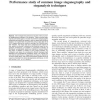Free Online Productivity Tools
i2Speak
i2Symbol
i2OCR
iTex2Img
iWeb2Print
iWeb2Shot
i2Type
iPdf2Split
iPdf2Merge
i2Bopomofo
i2Arabic
i2Style
i2Image
i2PDF
iLatex2Rtf
Sci2ools
JEI
2006
2006
Performance study of common image steganography and steganalysis techniques
Abstract. We investigate the performance of state of the art universal steganalyzers proposed in the literature. These universal steganalyzers are tested against a number of well-known steganographic embedding techniques that operate in both the spatial and transform domains. Our experiments are performed using a large data set of JPEG images obtained by randomly crawling a set of publicly available websites. The image data set is categorized with respect to size, quality, and texture to determine their potential impact on steganalysis performance. To establish a comparative evaluation of techniques, undetectability results are obtained at various embedding rates. In addition to variation in cover image properties, our comparison also takes into consideration different message length definitions and computational complexity issues. Our results indicate that the performance of steganalysis techniques is affected by the JPEG quality factor, and JPEG recompression artifacts serve as a sou...
JEI 2006 | Steganalysis Performance | Steganalysis Techniques | Steganographic Embedding Techniques |
| Added | 13 Dec 2010 |
| Updated | 13 Dec 2010 |
| Type | Journal |
| Year | 2006 |
| Where | JEI |
| Authors | Mehdi Kharrazi, Husrev T. Sencar, Nasir D. Memon |
Comments (0)

